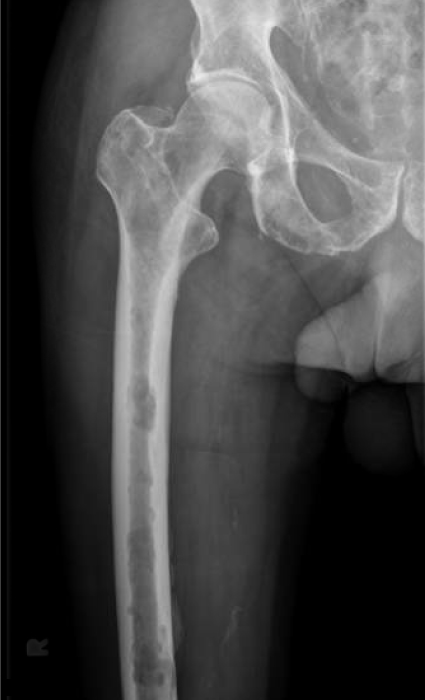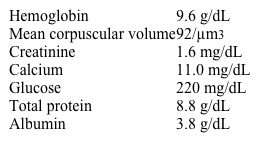A 66-year-old man comes to the office due to several weeks of back and lower extremity pain. The pain feels dull and achy and is worsened by movement, causing him to have difficulty bearing weight and ambulating. He has had no bladder or bowel dysfunction, extremity weakness, or numbness. The patient takes metformin for type 2 diabetes mellitus. He drinks 2 alcoholic beverages daily. Physical examination shows no gross abnormality or deformity of the back or extremities. There is no swelling or redness of the legs, and neurological examination is normal. A radiograph of the right lower extremity is shown in the exhibit.  Laboratory results are as follows:
Laboratory results are as follows:  Which of the following is the most likely explanation for this patient's bone changes?
Which of the following is the most likely explanation for this patient's bone changes?
A) Decreased urinary calcium excretion
B) Increased 1,25-dihydroxyvitamin D production
C) Increased secretion of parathyroid hormone
D) Local tumor cell-mediated activation of osteoblasts
E) Local tumor cell-mediated activation of osteoclasts
Correct Answer:
Verified
Q252: A 34-year-old male who is being treated
Q253: A 32-year-old woman comes to the office
Q254: A 65-year-old man comes to the office
Q255: A 3-year-old boy is brought to clinic
Q256: A 66-year-old woman is brought to the
Q258: A 45-year-old man comes to the office
Q259: A 30-year-old woman comes to the emergency
Q260: An 18-year-old woman collapsed while practicing for
Q261: A 2-year-old boy is brought to the
Q262: A 74-year-old woman comes to the office
Unlock this Answer For Free Now!
View this answer and more for free by performing one of the following actions

Scan the QR code to install the App and get 2 free unlocks

Unlock quizzes for free by uploading documents